How to Render Lard
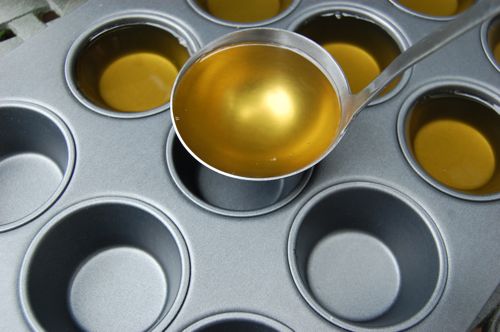
There’s something so elementally satisfying about the process of rendering lard, I…I don’t know how to fully express it. A sort of manly do-it-yourself pride combined with the boyish thrill of breaking a food taboo. As George Patton might have said: God help me, I do love it so.
The obvious question is: why? After all you can get lard in lots of places, especially Mexican grocery stores. My answer is: it’s fun to do and it tastes better. Home-rendered lard has no “xyz” additives if you’re concerned about those. Most importantly it has a milder, yet roasty-er flavor than the commercial stuff, since it’s made with higher quality fat and rendered at a higher temperature. Perfect for baking, in other words.
Be aware that the rendering of lard is something that’s best done outdoors, since rendering at its best is a long, slow process, and even relatively non-smelly leaf lard will still leave your house smelling like an all-day luau. You can render over a low flame or even better, in an oven. Since I’m in the very privileged position of having an outdoor brick oven, I do it there, with the residual heat leftover the morning after a pizza party. Crikey! Do I sound like Martha Stewart today or what? I don’t normally cook on an engine block, but if you happen to have a Bentley, the nice, flat piston covers are perfect for searing scallops after a jaunt to Martha’s Vineyard! I deserve all the ridicule that’s due me. Anyway, an oven temperature of 325 is about perfect.
Start with about 5-8 pounds of leaf lard (back lard will work also). As you can see, taken directly from the animal, it’s clumpy white with some greyish impurities (membranes and such) running through it. If you get it fresh off the farm, it will likely be in long pieces roughly in the shape of tenderloins. If you don’t know where to get any, ask a meat purveyor at your local farmer’s market. If they don’t have it, odds are they an tell you where to get it.

Cut the lard up into medium dice. If you’re using back lard, which will have more bits of meat in it, you’ll probably want to grind it instead. Place the fat in a roasting pan or Dutch oven.
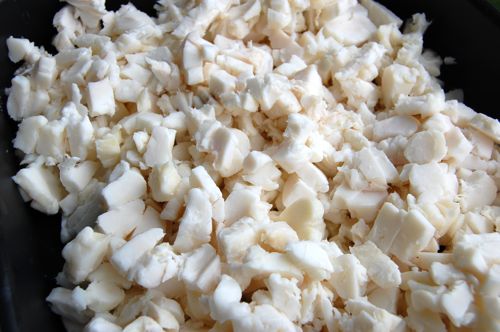
Here’s an important part: add enough water to come a quarter inch up the pan. This will keep the lard from scorching, which affects the flavor. Some people like it that way: roasty-tasting. For baking though, the more neutral, the better.
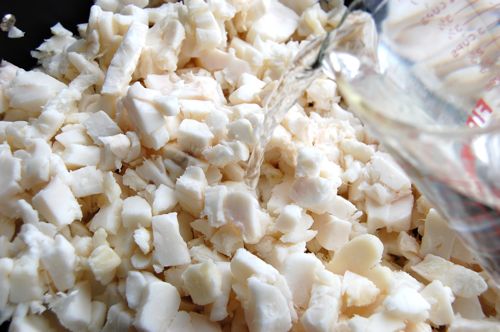
Insert the pan into your oven, or put it over a low flame. Below I’ve got mine on a rack to keep it off the oven floor, which is hotter than I want at the moment. It’s important to heat it up slowly, because the longer the render, the higher the yield. Leave the pan in the oven (or over a flame) for several hours, until the lard reaches a temperature of 255 – 260 degrees (mine took five hours). This is the temperature at which all the water will have boiled out, leaving nothing but the pure lard.

Oh, wait! What are those crisping, crackling things floating on top? They’re what are known among the leading households of Europe as cracklin’s. You’ll want to save those, trust me.

Using a ladle, begin to spoon the liquid fat out of the roasting pan.

Pour it through a sieve lined with several layers of cheese cloth into a large, clean pot.

When the fat level gets low and the pan starts to cool, simply pour all its contents into the sieve and press the cracklings down with the ladle to squeeze out the last of the liquid (you may have to tip the sieve a little from side to side since the cheesecloth will start to get clogged with bits). When you’ve gotten most of the liquid out, put the cracklings back in the pan and the pan back in the oven to crisp them.

Ladle the golden lard into muffin tins…

…and put the tins in the refrigerator. The lard can be left at room temperature to firm, but the more quickly the lard comes down in temperature the smaller the fat crystals will be and the finer the texture of the finished product. Once the lard has firmed in the fridge, put the tins into the freezer.
Oh, and what about those cracklin’s? Ah yes, another 45 minutes and they’re nice and crisp. What do you do with those? If you have to ask, you don’t deserve any. Send them here to me by overnight mail (address to follow).
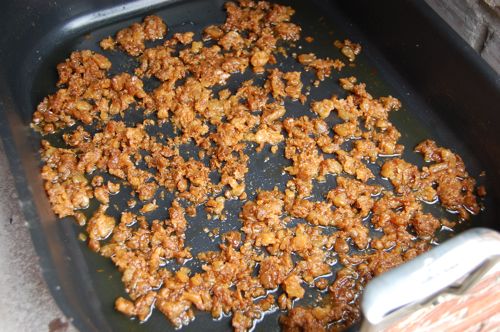
Now then, back to the lard. The next day, your frozen lard muffins will look about like this:
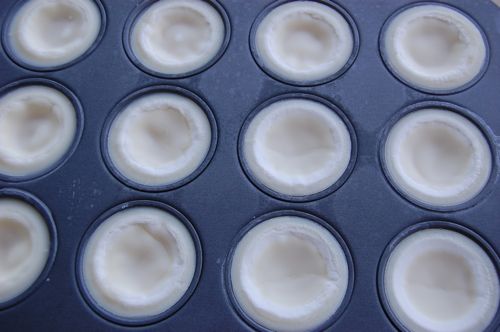
To de-pan them, insert a butter knife at the edge of the cakes…
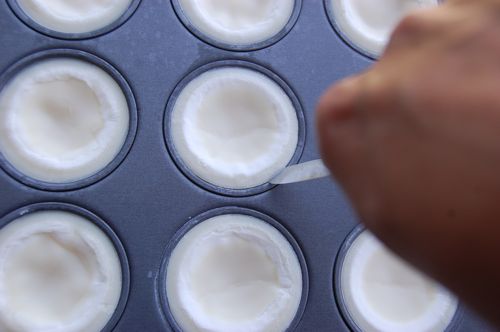
…and just pop those puppies right out.
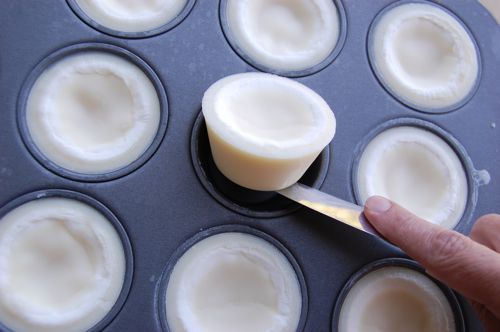
Put the cakes into plastic bags and store in the freezer for up to a year.
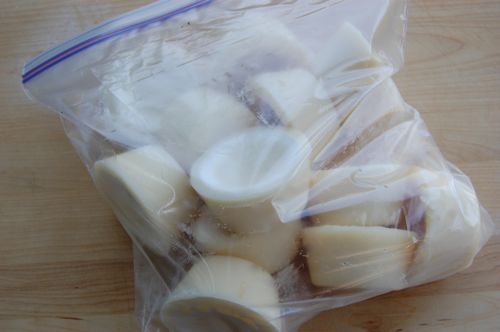
Lard will also store well in the refrigerator for a month. DO NOT store this kind of fresh lard at room temperature. It contains lots of unsaturated fats, and they’ll go rancid with time. Nope, for maximum enjoyment of your home-rendered lard, treat it well. Use for biscuits, pie crusts, breads, cakes, to cook or fry with.
Reader Kelly from Germany adds:
I wanted to put out there that rendering your
own lard (or goose fat, as I did this weekend) is a great way to
develop the seasoning on your cast iron fry pans. I know it’s not
really high temp, but somehow my big cast iron skillet has finally
started to get that black-satin finish that my older pans already
have.
Nice! Thanks Kelly!
Hi,
I’m from the Middle East. We use the rendered Lard for in many cosmetic things, and one of them is the use of it as hair grease but after adding many things to it to make it smell better
Fascinating, Suhaila. I’m so glad you wrote to me. Where do you live if you don’t mind my asking?
– Joe
I want beef fat for making Argentinian pastries (hi! it’s me from the post about making Argentinian pastries…back again!). whenever we grill meat the fat drips from the grill into a metal tin. since it’s already in liquid form I was wondering if, instead of discarding it, I could just strain it and freeze it to use in baked goods.
what are your thoughts?
Hi Ana. Drippings like that aren’t much good for baking since they have cooked bits of meat and especially water in it. Also firmer fats make better baked cookies, since they melt slower. But by all means try if you feel like running an experiment. I’ll be interested in your results!
– Joe
Hi Joe,
I have bought the kidney lard ( I have an organic, free range butcher) and am wondering how long you can keep the melted lard in the freezer? I too have heard only the best pastry is made from self rendered lard. The tip about using a cupcake/muffin tin is geat btw!
Thanks,
Marylin
Hi Marilyn! If you keep it in a airtight container away from off freezer odors, it’ll keep for up to a year.
And thanks very much!
– Joe
Hi Joe,
My brother-in-law gave me some lard he rendered and froze, but I need to mail it home (from MI to HI). If I send it (thawed) via USPS priority mail, will it keep until I can get it back into the freezer? Thanks very much for your help!
Miranda
Hi Miranda!
The answer is of course: it depends. Lard tends to keep pretty well at room temperature, but packages that get shipped this time of year tend to sit in very hot train cars and trucks, which means the lard could melt along the way and/or get a bit nasty. Honestly I can’t say I’d recommend it. Can you just bring it on the plane perhaps?
– Joe
For Ana, above. I get beef fat scraps from a butcher, grind them in a meat grinder and render them in the oven, following the same process as for lard. There’s nothing better for frying potatoes or the onions for French onion soup. I save the cracklings to add flavor to beef stock–after the household has eaten all it thinks it should!
I’m sure it would be better with the beef equivalent (Joe?) of leaf lard, but this tastes fine to us.
Thanks, Sally!
Joe-
I didn’t believe I was ever going to do this but I have a pot of pork fat cubes in a dutch oven on the store top right now! (Yes, you can tell me “I told you so” about doing it indoors later ; > )
I am making this variation on shepherds’ pie with confit pork with it. And if it comes out white enough I’ll save some for Thanksgiving pie.
Thanks for all the wonderful info you share with us!!
http://food52.com/blog/8328-pork-confit-shepherd-s-pie
Woohoo!
How did it turn out?
– Joe
Hi Joe,
I am Chinese and I have recently started rendering lard on stove top for all my stir-frying.
Sure beats all the commercial cooking oil that comes in plastic bottles.
It certainly does! Nice to meet you, Tash. Please come back often!
– Joe
I just found your blog today! I know, I know- what rock have I been hiding under, right? I’m learning so much as I read your posts. For those of us not fortunate enough to have an outdoor pizza oven, is a gas barbecue using offset heat a possibility? I know it’s tricky to control the temperature on the grill, but I know my smoke detector is too finicky for me to attempt this indoors.
Thanks for the great reading I have enjoyed today!
Hey Patti!
Nice to have you aboard — thanks very much for the kind words! A lot of people grill pizzas these days with excellent results. Also a lot of grill makers are producing inserts of various types that simulate brick oven heat. I’d look into those. You never know what’s around. There are a lot of people turning grill into pizza ovens these days!
Cheers and thanks again for dropping by. Come back soon!
– Joe
I’ve barbecued pizza on the grill plenty of times with great success (after re-reading my comment, I realize I didn’t make myself very clear)! In conjunction with rendering the lard, however, do you think the barbecue is a possibility?
Hey Patti!
My fault as well…I’m still not understanding the question. Are you asking if you can use a gas grill to make barbecue…as in ribs? Or are we still talking pizza?
Sorry for the confusion…barbecue can be a noun and a verb, and my small brain is easily muddled. 😉
– Joe
Forget I mentioned anything about pizza.
😉
One more question (sorry to be a pest)- is leaf lard different from other lard? I’m having a hard time finding “leaf” lard. I’ve called a couple of meat markets and they seem to be clueless as to what leaf lard is.
Hey Patti!
Leaf lard is indeed difference from other lard. There’s a post about it here:
http://joepastry.com/2014/good-lard-is-where-you-find-it-2/
Farmer’s market meat purveyors usually have access to leaf lard. That;s the best police to check!
Cheers,
– Joe
Hi Joe,
Just found your website (was looking for an explanation of French flour types) and am delighted what I found.
I am originally from Austria (now live in Australia) and we always had a pot of lard handy. Actually, my mother gave me a pot full of gorgeous white loveliness on my wedding day. She couldn’t let me get married without ‘white gold’. It’s great as part of frying schnitzels.
Now, for the leftovers… Apart from mixing them with salt into some of the lard and have them on sourdough bread, you can also use them as fillings in dumplings, or as my mother-in-law taught me, mince them and put them as a layer on top of rolled-out sweet yeast pastry, fold over and roll again to get a few ‘layers’. Bake as a sheet cake. Dust with icing sugar. It’s just amazing. Initially I couldn’t imagine it but was so surprised when I tasted it.
So, there is food for thought!
Cheers, Ingrid
FABULOUS Ingrid! And very timely too. I just rendered a large batch of lard and have a container of “cracklin’s” in the refrigerator. I will try these ideas immediately!
Thank you,
– Joe